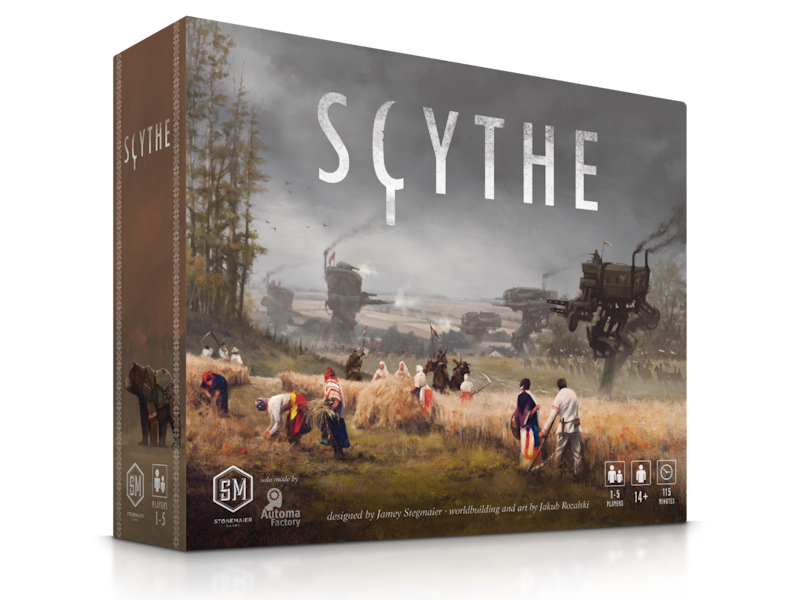Scythe
review by Luka
What is Scythe?
Scythe is a 1-5 player competitive strategy wargame set in an alternate history post-war 1920’s Eastern Europa. Created by the game’s artist, Jakub Rozalski, the setting features distinct factions inspired by real nations, each led by a character with an animal companion. Each player represents one of these characters as they leverage their unique faction abilities, positioning, workers, resources, and up to four dieselpunk mechs to gain fame and fortune. To win, a player must end the game with the most money, and the game ends once a player earns 6 achievements (each worth an amount of money).
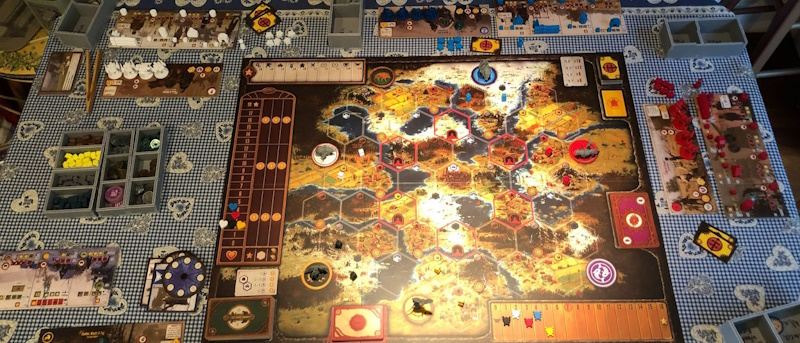
Overview of the Scythe game set up, ready to play!
Scythe Setup
Scythe’s setup starts with shuffling the various cards that are used throughout the game, including encounter, objective, combat, and factory cards. They are all then placed on their appropriate spots on the game board. Additionally, a structure bonus tile, randomly drawn, is placed just below the Popularity track. This reveals an additional way players can earn money at the end of a game. Lastly, for general setup, encounter tokens are placed on each territory marked with an encounter symbol. These allow players to interact with encounter cards and tell a story about their leader.
Next, the game rules dictate that players are randomly dealt one Faction Mat and one Player Mat. Since my friends and I naturally gravitate towards some factions more than others, we only randomly distribute the Player Mats, instead agreeing beforehand on who plays which faction.
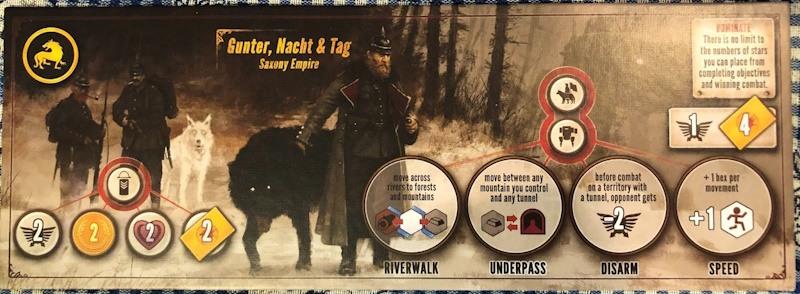
The Faction Mat for Saxony. On the right-hand side, it denotes that the player starts with 1 Power and 4 combat cards.
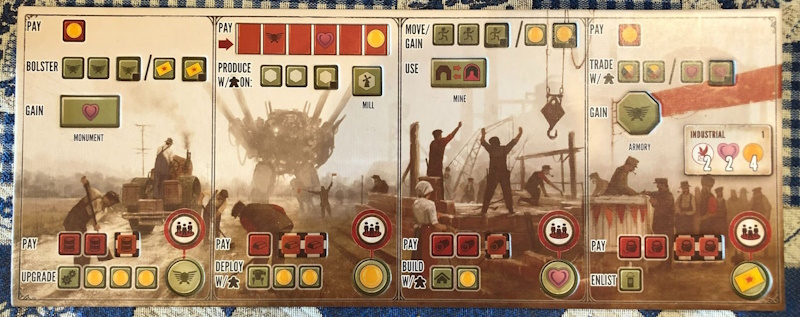
The Industrial Player Mat. The right-hand side denotes that the player starts with 2 objective cards, 2 Popularity, and $4.
With experienced players, Stonemaier Games also recommend banning the combination of the Rusviet Faction Mat with the Industrial Player Mat, and the Crimea Faction Mat with the Patriotic Player Mat, as they have been deemed too efficient for others to compete with. Both the Faction and Player Mats give starting cards, money, and track positions which the player acquires now. To denote their track position, they use a heart-shaped Popularity token on the Popularity track, and a Power token on the power track, both located on the game board.
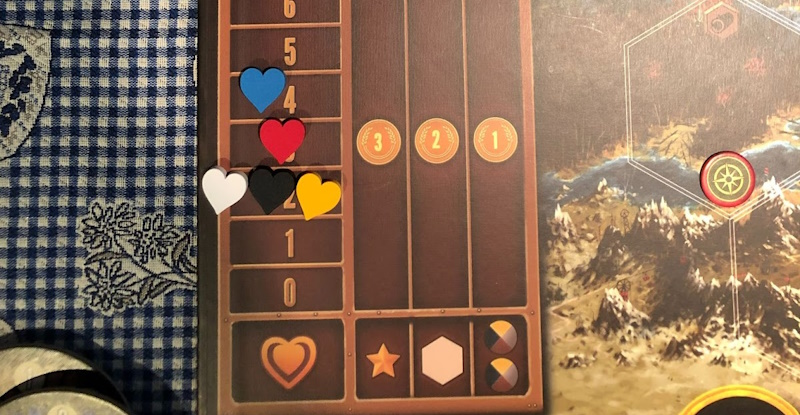

The Popularity and Power tracks.
After doing so, the Faction Mat requires the player to place their four mechs over the large circular spots on the Mat. Within these circles are different abilities that the player can unlock for their mechs and character once they deploy the associated mech. The Player Mat requires the player place four wooden Structure tokens over the slots labeled armory, monument, mine, and mill. The player then places four Recruit tokens over the green circular slots at the bottom of the Mat. Next, they place six of the eight workers on the red slots above the “Produce” action. And finally for Player Mat setup, they place the six small technology cubes in the green recessed squares on the Player Mat.
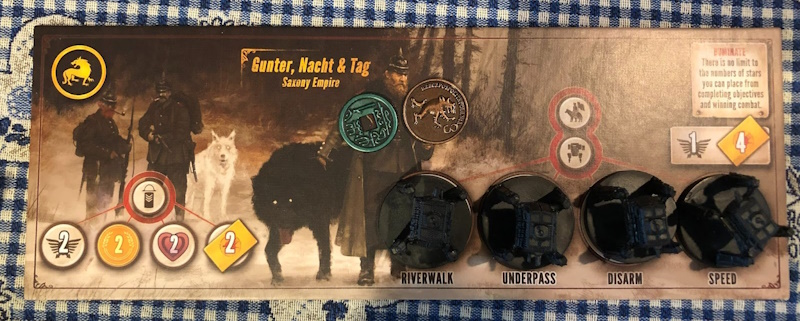
Filled Saxony Faction Mat.
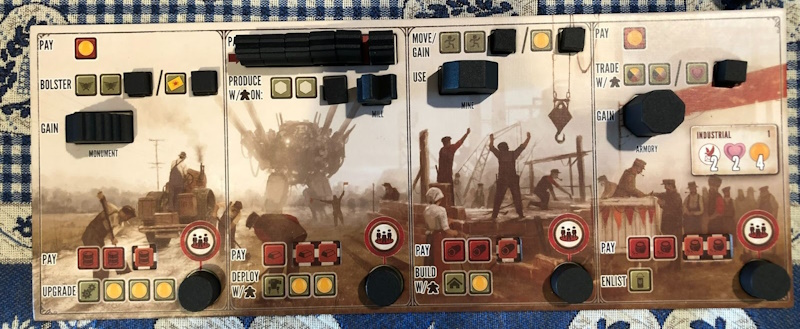
Filled Industrial Player Mat with Saxony game pieces.
The last step required for setup is for the players to place their character in their Faction’s home base, and the two remaining workers each on adjacent territories. Additionally, players should sit close to their Faction’s home base.
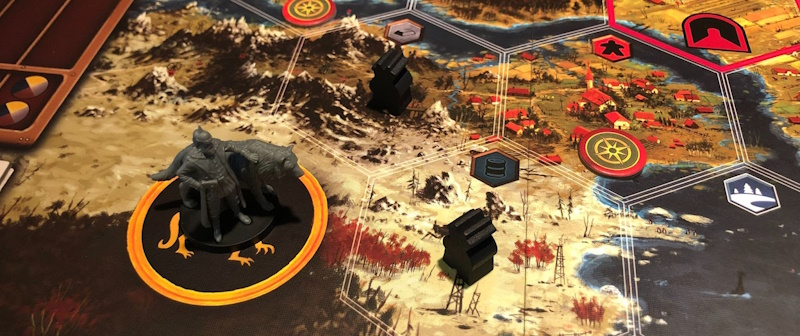
Saxony’s character, Gunter, on their home base with two workers in adjacent territories.
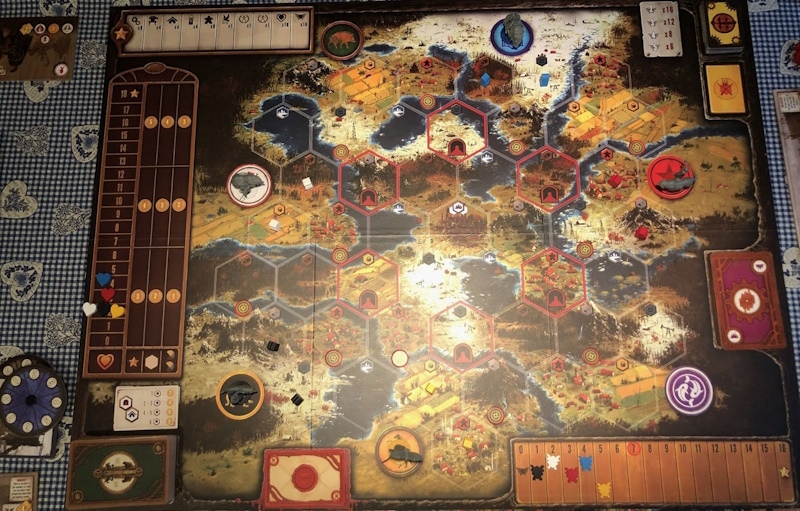
An overview of the starting board.
Scythe Gameplay
In Scythe, players go around the table taking turns performing actions listed on their Player Mat to earn achievements and end the game with the most money. The possible achievements a player can earn are completing all 6 upgrades on their Player Mat, deploying all 4 mechs, building all 4 Structures, enlisting all 4 Recruits, having all 8 workers on the board, revealing and completing an objective card, winning combat (up to two times), having 18 Popularity on the Popularity track, and having 16 Power on the Power track.

The achievement list on the board. Once a player earns one, a star is placed on the proper spot.
Each Player Mat has two rows of actions, noted as top-row and bottom-row actions. These actions are paired up—one top-row and one bottom-row action—in 4 different sections on the mat. On a player’s turn, they take an action token to one such section that they didn’t choose last turn and may perform the top-row, the bottom-row, or both actions (starting with the top-row action) of that Player Mat section. Top-row actions are all the same between Player Mats, only the section positioning on the mat changes, while bottom-row actions appear in the same section every time, but with different resource requirements to perform them.
Top row-actions include Bolster, Trade, Produce, and move. The Bolster action can be taken at the cost of $1 to either gain 2 Power (3 when upgraded) or draw a combat card (2 when upgraded), both being resources that can be used to win combats.
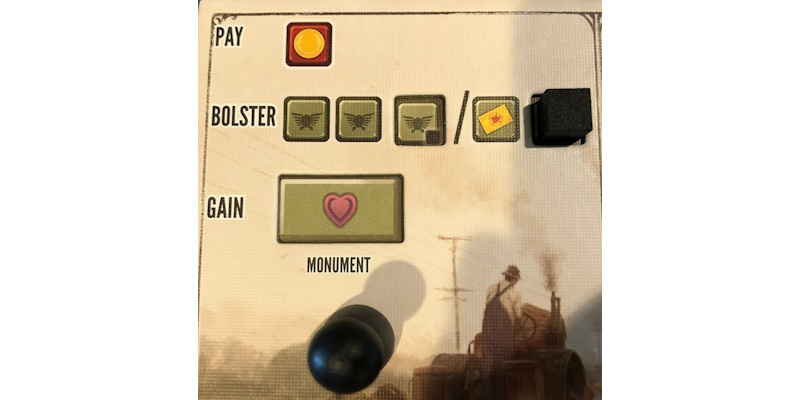
Bolster action that has been upgraded once to optionally provide 3 Power and whose monument Structure (providing Popularity) has been built. Below it is the action token.
The Trade action costs $1 to gain any two resources at any territory the player has a worker, or to gain 1 Popularity (2 when upgraded).
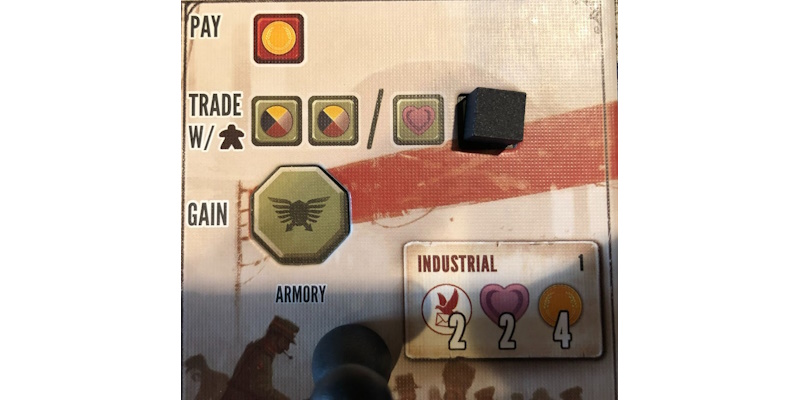
The Trade Action with no upgrades, but the Armory has been built, providing Power.
The Produce action allows the player to Produce up 2 different territories (3 when upgraded) to gain an amount of resources equal to the number of workers on each territory. The type of resources Produced depends on the territory’s terrain type, for example, mountains Produce metal, tundras Produce oil, and villages Produce more workers. The more workers a player has, the more expensive the Produce action becomes.
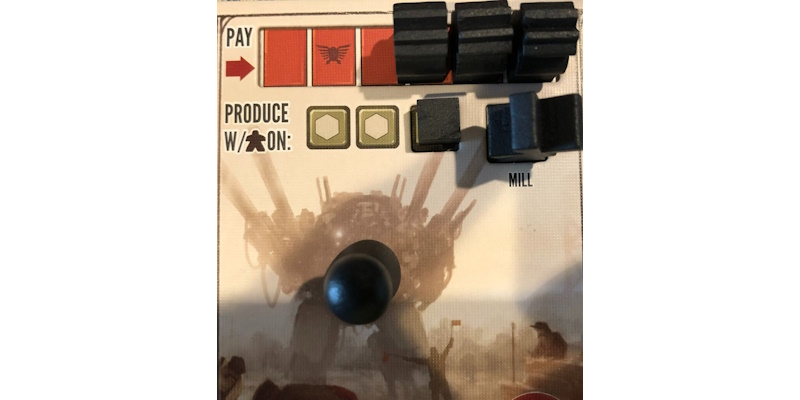
The Produce action with no upgrades. Usually, the action would be free, but since there are 5 workers currently on the board for the Saxony player (the starting 2 plus the 3 that were taken from the Player Mat), now the action takes a Power to perform.
The Move action is by far the most complex and strategic top-row action. It allows the player to move two separate units each 1 territory (workers, mechs, and characters are units) taking any number of resources with them from the territory(s) they leave; however, there are several restrictions to movement.
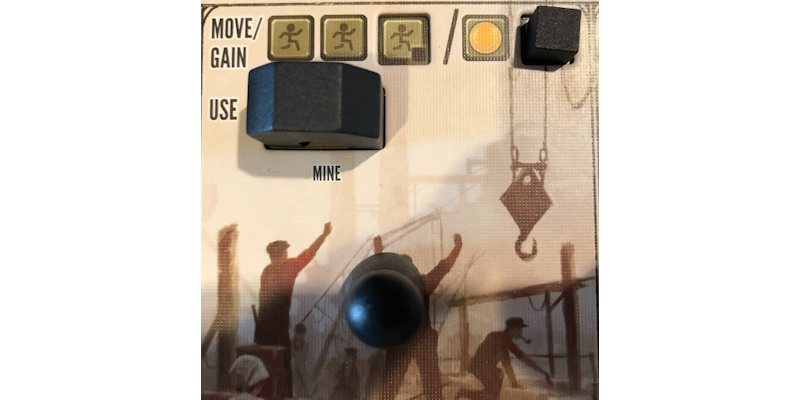
The move action upgraded to be able to move 3 different units.
Normally, no unit can traverse rivers or lakes, but each Faction possesses a “riverwalk” mech ability which lets their character and mechs traverse certain points of rivers. Additionally, workers can be picked up by mechs to be moved as a group. Doing this also enables workers to be moved over rivers via the mech’s riverwalk ability.
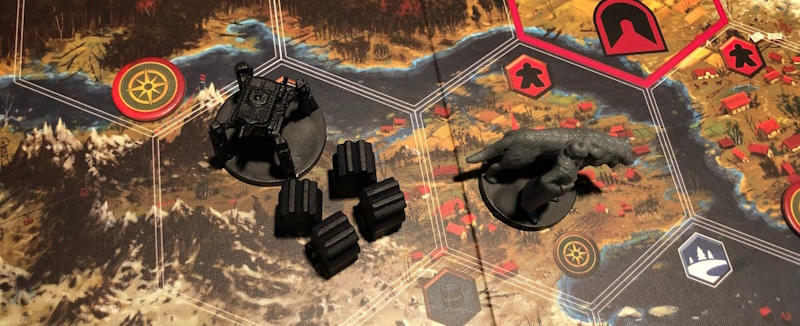
In this example here, the Saxony player can move all 4 workers on the mountain tile with their mech’s move. Additionally, the Saxony Empire’s riverwalk ability allows them to cross rivers onto forests or mountains. Therefore, the mech could move to the adjacent forest territory and bring its workers along for the ride.
Workers also can’t enter enemy controlled territory on their own, but mechs and characters can; when they do, they initiate combat. Against only workers, the attacking player simply sends all enemy workers back to the opponent’s player’s home base and the aggressor loses popularity equal to the number of workers sent back. Against another mech or character, each player must secretly bid up to 7 Power from the power track, and an amount of power cards equal to the number of mechs/characters they have fighting. Whoever ends up with a higher number across Power spent and cards played wins the combat and stays in the contested territory with all resources present. The loser gets all their units sent to their home base.
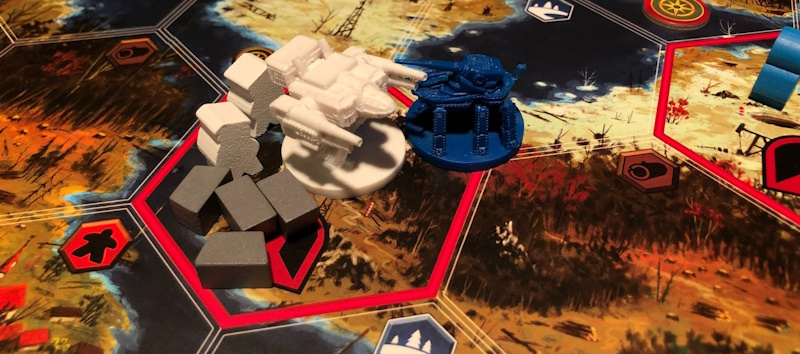
In this example, the Nordic Kingdom player is attacking a territory with a Polania mech in an attempt to raid their metal resources.
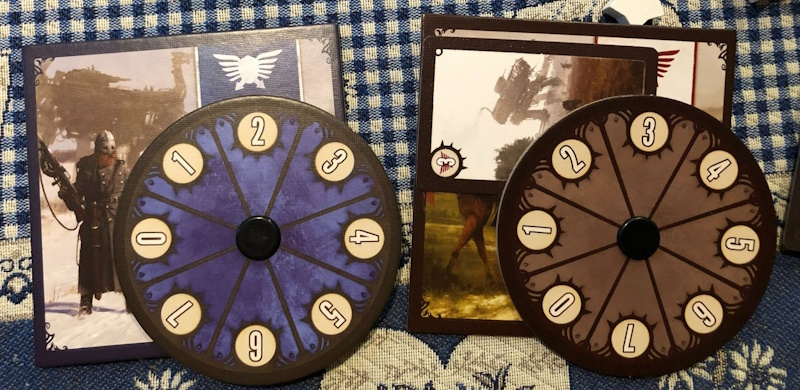
The Nordic player only bid 2 of their Power to this combat, while the Polania player bid 3 Power, plus a combat card to bring their total up to 6. Therefore, the Nordic player is forced to retreat their mech.
When a character moves onto a territory with an encounter token, the player discards the token and draws an encounter card. They then show the card art to the table and choose one of three options for how the character acts in the Encounter, giving different rewards.
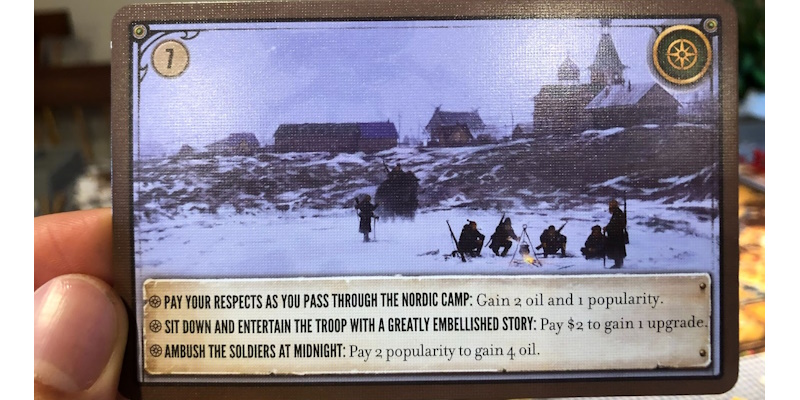
An example of an Encounter card.
Another unique event happens when a character ends their movement in the center territory of the board, known as the Factory. When they do so, they draw an amount of Factory cards equal to 1 + the amount of players who haven’t reached the Factory yet. The player chooses one of these cards then adds it to their Player Mat. In doing so, they gain a new section to their Player Mat with powerful combinations of actions.
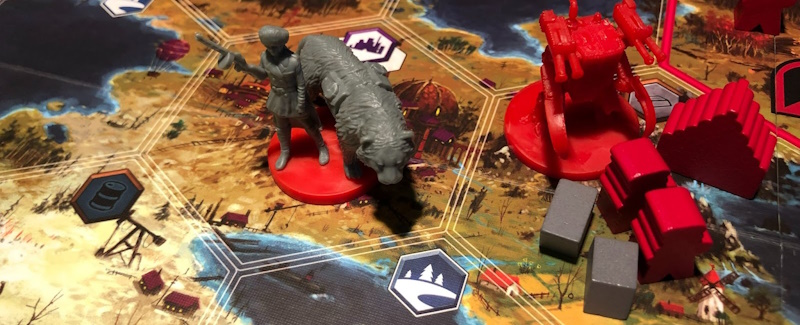
The Rusviet Union player has reached the Factory.
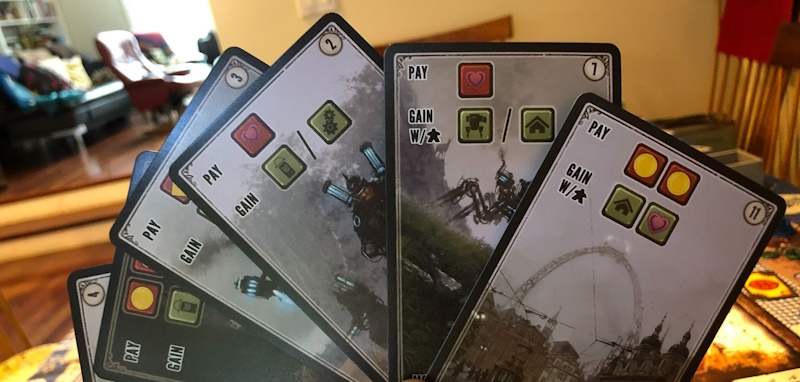
A list of Factory cards that can be selected by the Rusviet player.
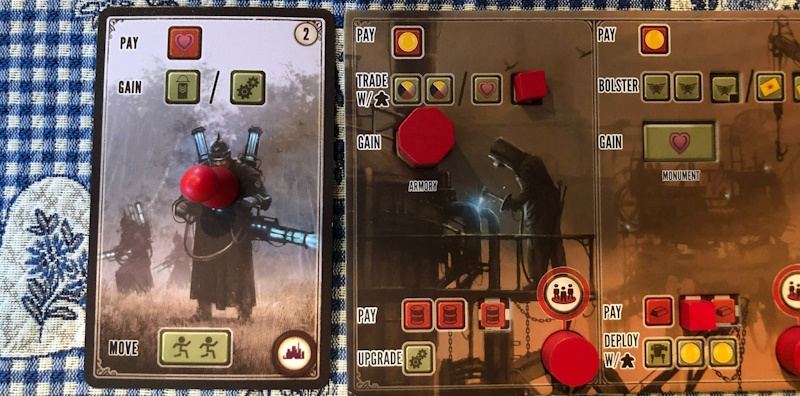
The Factory card the Rusviet player chose alongside their Player Mat, with their action token present on it denoting they just took the actions on the card.
After taking a top-row action, players can then take the bottom-row action present in the section they activated. Possible bottom-row actions include upgrading their Player Mat, deploying a mech, building a Structure, and enlisting a Recruit. Each of these actions take resources to perform, and depending on the cost, can grant the player an amount of money (up to $3). The first action, upgrading, uses oil to perform and allows the player to move a technology cube from a top-row action over part of the cost for a bottom row action if the section on the Player Mat is recessed. In doing so, a top action becomes better while a bottom action is simultaneously made cheaper.
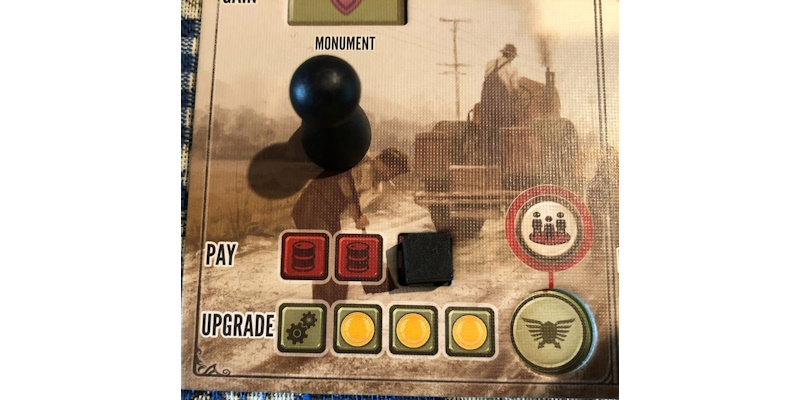
The upgrade action has already been taken, and it has been made cheaper via a technology cube covering what would be a third oil resource in its cost.
The second bottom-row action is deploying a mech, which costs metal. When doing so, the player may take one of the mechs remaining on their Faction Mat and place it anywhere they have a worker. When this happens, whatever ability that mech was covering on the Mat becomes available for the player’s mechs and character to utilize. Riverwalking is one such ability, alongside three others that make each Faction unique.
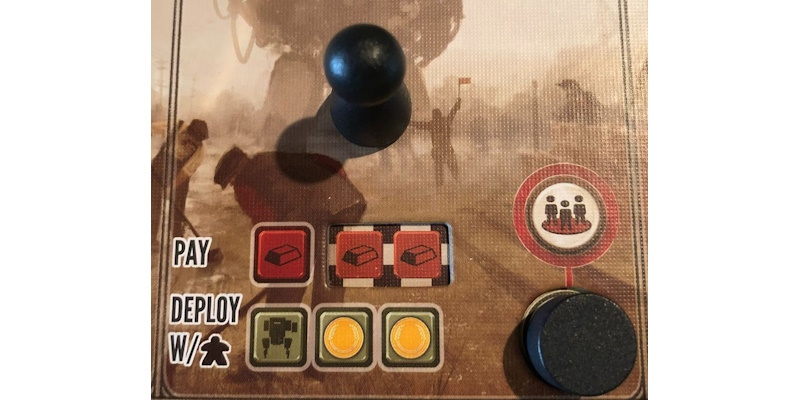
A not upgraded deploy action.
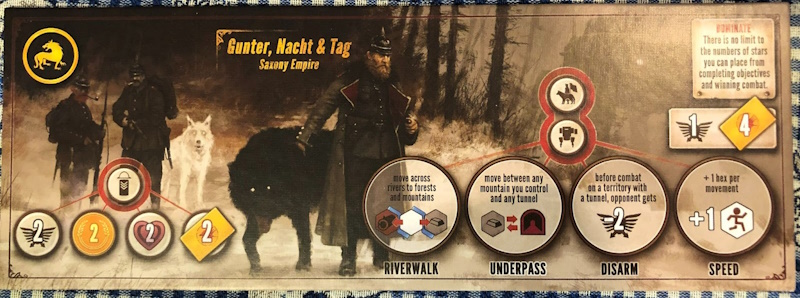
Saxony’s mech abilities.
The third bottom-row action is building a Structure, which takes wood. These Structures can be built on a territory wherever the player has a worker, and no other Structures present. Each Structure built improves an associated top-row action; therefore there are four total Structures. These include the monument, which makes the Bolster action also give 1 Popularity; the armory, which makes the Trade action also give 1 Power; the mill, which allows the mill’s territory to Produce resources as a worker in addition to the other territories part of the Produce action; and the mine which functions as a personal tunnel. Tunnel territories are marked in red, and a player can move a unit from any tunnel territory to another in a move action. The mine acts as a tunnel for the purposes of the owning player’s movement.
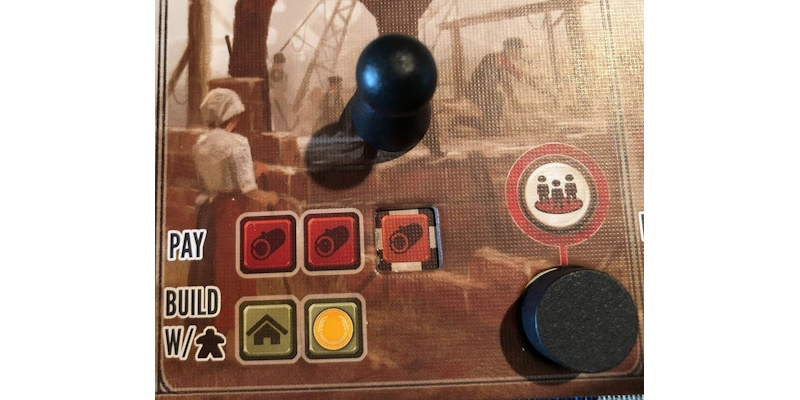
The build action.
In addition to their normal benefits, Structures can earn a player more money depending on how they’re built. Every game has a Structure bonus which grants extra money to each player at the end of the game if they fulfill it. These could be the player having Structures built in a straight line, having Structures adjacent to tunnels, etc.
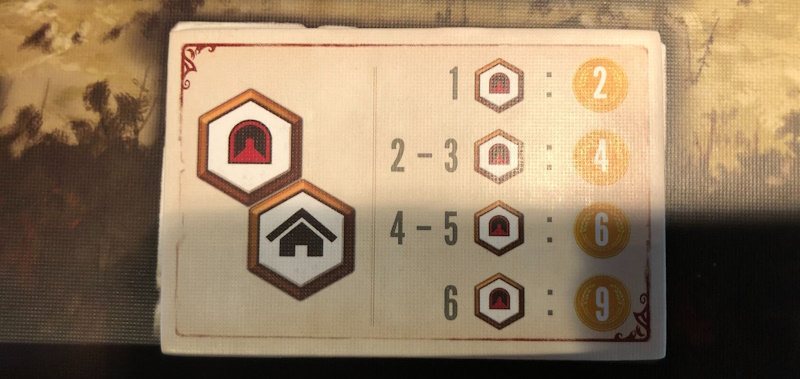
Structure bonus for having Tunnels next to a player’s own structures.
The last bottom-row action is enlisting a Recruit, which costs food. When performed, the player removes a cylindrical Recruit token from a bottom-row action and places it over an uncovered circle on the left-hand side of their Faction Mat. In doing so, they gain the benefit from the circle they cover, while the newly uncovered circle next to the bottom-row action becomes an ongoing bonus. Now whenever that player, or when the players to their right and left take the associated bottom row action, they now gain the benefit from the ongoing bonus. These ongoing bonuses include 1 Power from the upgrade bottom-row action, $1 from the deploy a mech bottom-row action, 1 Popularity from the build bottom-row action, and 1 combat card from the enlist bottom-row action.
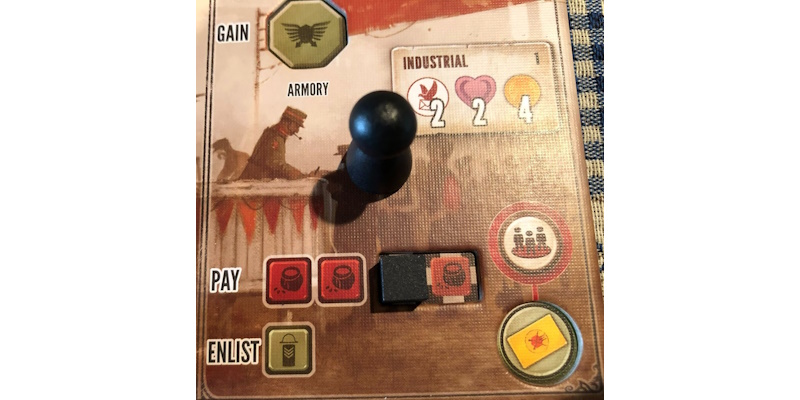
An upgraded enlist action, so it only costs 3 food instead of 4. The enlist action has been taken before, and has removed the Recruit token from that action. Now whenever the player, or the players to the right and left, take an enlist bottom-row action, they’ll gain a combat card.
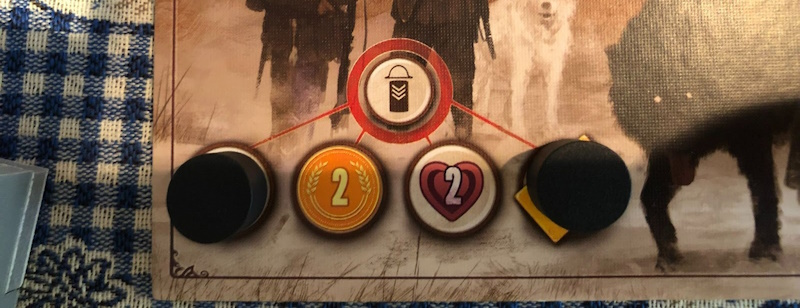
The Saxony player has enlisted a Recruit twice, placing their tokens over the immediate 2 Power and 2 combat cards benefits.
Once a player earns 6 of the possible achievements, the game ends and final scoring is conducted. In addition to the Structure bonus, money is awarded for each achievement a player has earned, every territory they control, and for every two resources they have. Based on a player’s positioning on the Popularity track, they’ll earn more money for each of these. For example, between 0 and 6 Popularity, each achievement only grants $3, while 7-12 grants $4.
The last, and very crucial, gameplay element to keep in mind is the asymmetric nature of the Factions and their abilities. Each Faction has not only a unique starting point on the board, but different special and mech abilities. For example, Saxony’s special ability is called “Dominate,” which gives no limit to how many achievements the player can earn from winning combat or completing an objective card. Furthermore, Saxony also possesses two mech abilities in “Underpass,” and “Disarm.” Underpass allows the Saxony player to move from and to any mountain and tunnel territory on the board, and Disarm reduces the Power of the player they fight on tunnel territories. These abilities incentivize the Saxony player to be very aggressive, particularly with tunnel territories. To contrast, Polania’s special ability allows the player to pick two options from an Encounter card instead of just one. Polania’s mech abilities, “Submerge” and “Camaraderie,” let them move to and from lake tiles and not lose Popularity when forcing workers to retreat respectively. As a result, Polania encourages more exploration focused gameplay, allowing them to traverse where most Factions can’t and not worrying about the loss of Popularity for the sake of gaining big benefits from Encounters.
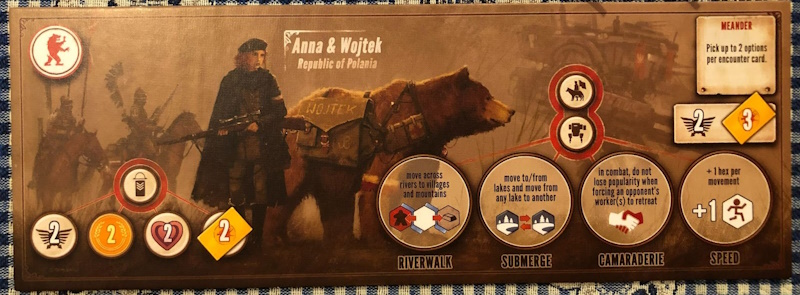
Polania Faction Mat with abilities.
The other Factions include the Rusviet Union, focused on maintaining a centerboard position around the Factory and production; the Nordic Kingdoms, focused on repeated assaults from lakes and early expansion; and the Crimean Khanate, focused on maneuverability and harassment.
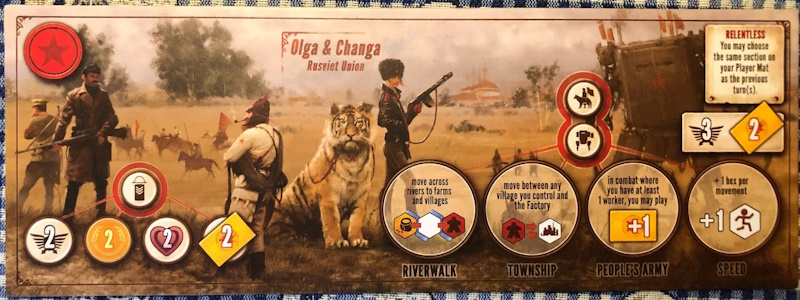
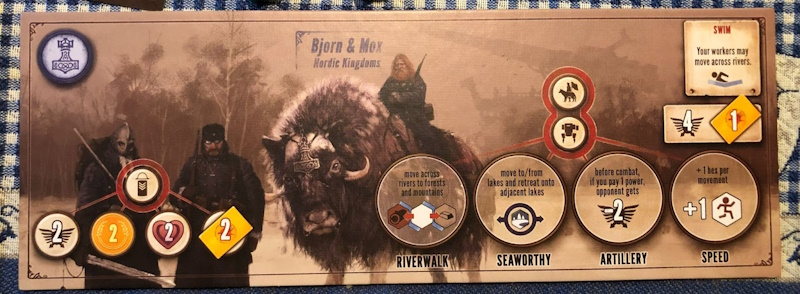
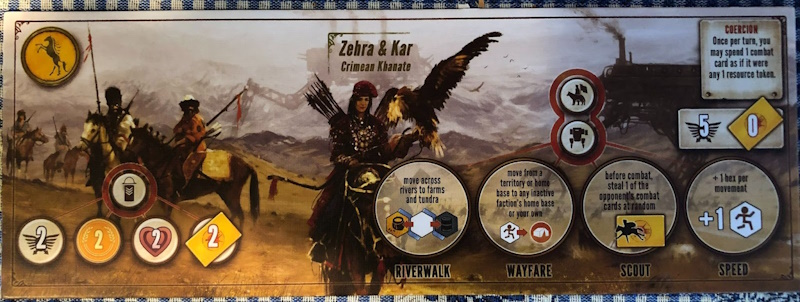
Final Review
I really enjoy Scythe for its complex interactions, asymmetry, and aesthetics. The Player Mats chunk player actions in a simple manner through the pairing of top-row and bottom-row actions in different sections. In doing so, it makes the actions easier to digest, instead leaving the difficulty up to the interactions that can arise from performing actions and the efficiency puzzle that derives from determining the best order of actions to set oneself up for success. For example: would it be best to spend your early turns on Produce and Trade actions to get as much metal as possible to deploy mechs and gain their abilities, or perhaps getting food is better since enlisting a Recruit would give more benefit throughout the game? Or maybe some move actions are in order to get your character to an Encounter for potentially a bigger benefit?
I’ve always been a fan of games with asymmetric aspects, as it adds much more variability to be mindful of when playing, and it gives a sense of identity to the role, character, or faction you play as. Scythe is no different, with its Factions all having their own abilities, strategies, backstories, and main character.
Some smaller mechanical aspects that I like about Scythe is the importance of positioning and how much risk there is in positioning and combat. As an efficiency game, positioning is key for a player to get their units in the right spots when needed. Therefore, when positioned correctly, it feel really satisfying to move or perform other actions just the way you need it to, while failing to position correctly possibly leads you to a 1 or 2 turn delay. Or a malposition could result in more turns of delay, as perhaps several workers are forced to retreat from an opponent. This also leads into a potential strategy: since players are forced to stop moving on a tile where there’s an enemy, even if it's just a worker, a scattering of workers could prove very annoying to players as they have to contend with slower movement and losing popularity.
When it comes to combat, the Power-bidding system makes it a mind game, as typically you don’t want to lose, but investing too much could just leave you vulnerable to just losing later due to a drained Power and/or combat card supply. Or, even worse, spending too much Power could leave another more critical territory vulnerable. As a result, even a player who has a lot of Power to spend must still be cautious about using it.
One major aspect of Scythe that I haven’t mentioned yet throughout this review is the aesthetics. The art by Jakub Rozalski brings the game and its world to life. Inspired by late 19th century and early 20th century realistic landscapes, the artwork grounds the setting in reality despite the fantastical nature of the animal companions the Faction leaders have and the dieselpunk mechs. Additionally, the ever-present fog in the artwork gives a foreboding feeling that is iconic. Compounding this ominous feeling of foreboding and tension are the mechs and other imaginative elements of technology which loom over the subjects in the art, mostly obscured by the fog. It provides the message that no matter what, you can’t escape war and its industrialization.
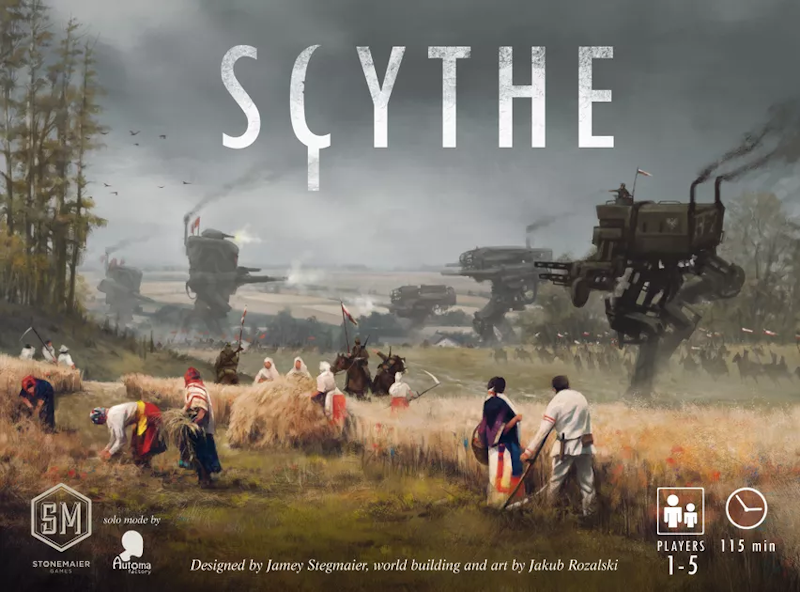
The cover art exemplifies the ominous and looming presence of the mechs best. The presence of the farmers working contrasts the battle, making the mechs seem almost alien and superior while also implying that battles like these have become mundane and expected as the farmers lack a reaction to the conflict.
The looming presence of mechs and technology especially present in the Encounter cards. The Encounter cards provide a narrative to games, as it offers an opportunity for the players to directly interact with the world of Scythe through the decisions you make for your leader. As a result, the situations they depict through their art give the means to view the world from the lens of an average person.
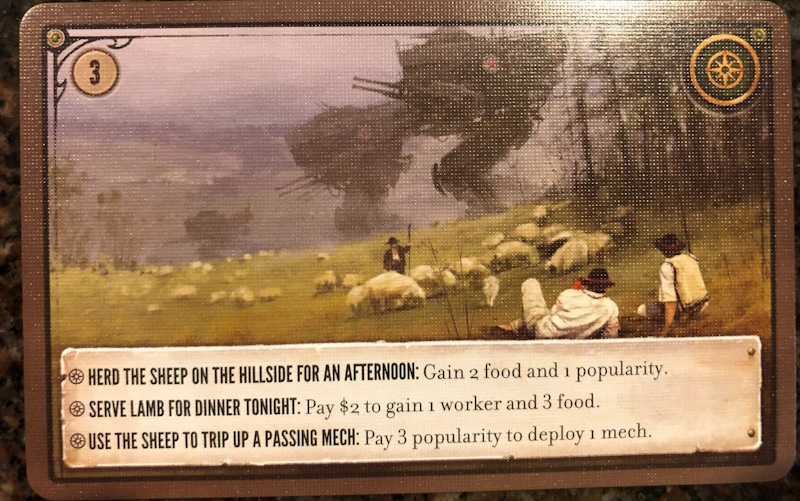
An Encounter card primarily featuring shepherds in the foreground, and the ominous mechs in the background.
Outside the artwork, the plastic miniatures also offer a tactile and visually pleasing experience. The characters and mechs are suitably imposing for their gameplay and lore significance. And while I haven’t done so yet myself, the characters and mechs have interesting enough details to paint as well. However, they aren’t the greatest quality to do so, as there are some hard to remove mold-lines, and Zehra and Kar from the Crimean Khanate offer a bizarre challenge as the space between their bow shaft and the drawstring is filled with plastic instead of being kept empty. Additionally, the models can bend easily at extremities such as gun barrels.
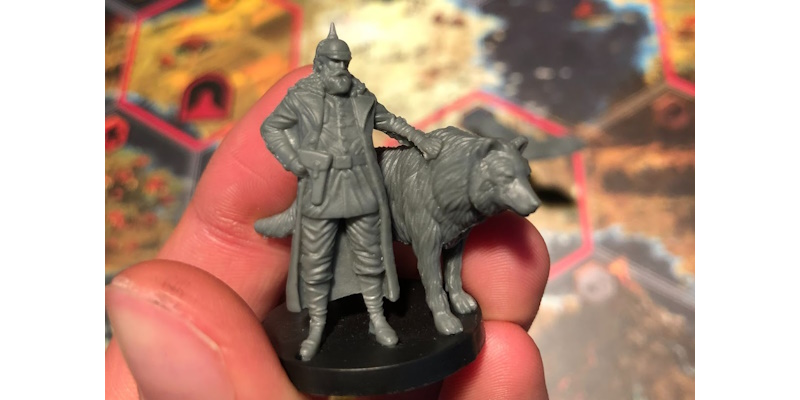
Gunter & Nacht’s Miniature from the Saxony Empire.
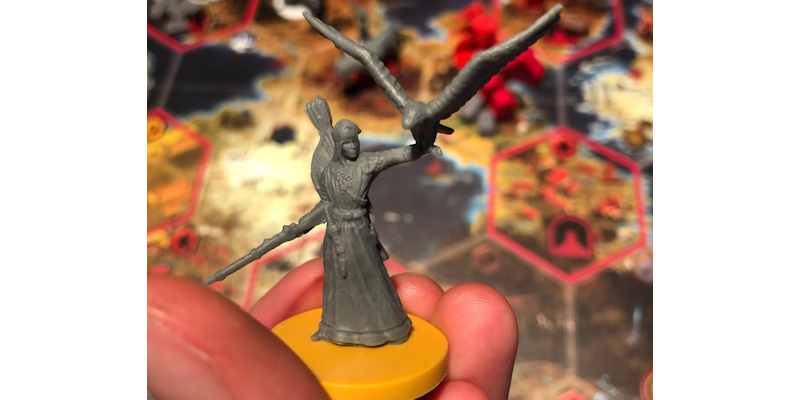
Zehra & Kar’s miniature from the Crimean Khanate.
Scythe isn’t a game for everyone, however; if you’re looking for something that’s quick to pick up and play, Scythe probably isn’t for you. There’s a lot of complexity to the player interactions and in the strategies one can employ to be as efficient as possible. This is to the point where, much like chess, you can argue about what a Faction’s best starting moves are. That, however, is made more difficult due to the randomness of the Player Mat you receive. Additionally, some combinations of Player and Faction Mats can feel difficult to play with, such as Polania with the agricultural Player Mat. Since their starting area lacks any mountains, they are forced to trade multiple times for metal to be able to deploy a mech to gain either their riverwalk ability or submerge ability so they can start expanding outwards. For a newer player, this feels awful, but an experienced player could notice that the agricultural Player Mat rewards a lot of money for the enlist action. And since they start near a village and a farm, they could make the decision to invest their early actions in enlisting all their Recruits first, or do both deploying mechs and enlisting at a slower, but more balanced pace. As a result, Scythe is a game that definitely gets better the more you play as you have more experience to leverage to make strategically sound choices.
Ultimately, I enjoy the complexity and depth the game offers despite the hurdles they can be. It’s complex games like Scythe that quickly become my favorite as there’s a lot for my teeth to sink into. And of course, the unique factions and beautiful art leave me enraptured by the game’s setting. These aspects of Scythe come together at such a level of quality that it stands out mechanically and aesthetically. I’d recommend Scythe to any group of players who are looking for a game to keep returning to, whether that be for the challenges to their strategic thinking (whether new to complex board games or not), or for the exploration of the art and the setting.
Scythe is available now from our webstore.
